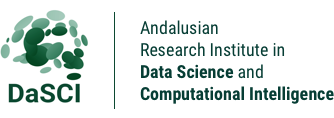Deep Learning Course 2nd Ed [Online]
07/15/2019 to 07/26/2019
The great technological impulse that we usually refer to under the term Big Data has revolutionized the business environment. For the first time in the history of AI there is a widespread demand for systems with advanced intelligence, equivalent to that of a human, that are capable of processing such data.
The aim of this course is to describe and discover the Deep Learning approach under the paradigm of unsupervised learning, where algorithms are able to learn without prior human intervention, drawing their own conclusions about the semantics embedded in the data.
Teaching team:
- Francisco Herrera (coordinator)
- Alberto Castillo
- Anabel Gómez
- Rosana Montes
- Francisco Pérez
- Siham Tabik
- Cristina Zuheros
More information
Big Data has revolutionized the business environment. For the first time in the history of AI there is a widespread demand for systems with advanced intelligence, equivalent to that of a human, that are capable of processing such data. We are Big Data spread to encompass all organizations and all sectors.
Machine learning algorithms are easy to understand if we analyze how to learn ourselves from childhood. Reinforcement learning encompasses a group of automatic learning techniques that we often use in artificial systems under the name of Supervised Learning (because it requires human intervention to indicate what is right and what is wrong). Under the paradigm of unsupervised learning, algorithms are able to learn without prior human intervention, drawing their own conclusions about the semantics embedded in the data.
The aim of this course is to describe and discover the Deep Learning approach. It is characterized by logical structures that resemble to a greater extent the organization of the mammalian nervous system, i.e. artificial neurons. These neurons specialize in detecting certain characteristics present in perceived objects. These characteristics are more easily discovered by the machine than by the human eye.
Teaching Methodology
2 ECTS (i.e., 40 hours), distributed in distance (synchronous) face-to-face sessions and autonomous individual work (as an asynchronous activity).
The virtual classes will be taught using the ZOOM videoconference system that allows to share the lecturer’s screen, an interactive whiteboard, the audio and video of the participants, and finally a chat. All these resources will be exported from ZOOM and shared on the eCampus platform. The platform will have other resources in addition to the course contents, as well as communication tools (messaging and forums) and qualification tools.
During the theory and practice classes, together with the teacher, there will always be the figure of a teacher monitor of the room, to answer questions that may arise in the chat, as well as the need to interrupt and ask a question using the local audio system of the Tecnológico de Monterrey.
In addition, the practical sessions are held in parallel for groups A and B, so that the size of the group can be reduced by half and teachers can better serve the participants. The group to which it belongs can be consulted on the eCampus platform.
In order to pass the course, it is necessary to obtain 50% of the qualification awarded for carrying out a monitored practical work, as well as to attend at least 80% of the distance face-to-face sessions. This information will be collected and managed automatically by the eCampus platform, as well as with signature sheets at the local headquarters of Tecnológico de Monterrey.
Academic Contents
Theoretical Part: (15 synchronous hour)
- Introduction: Neural Networks and Deep Learning (1 h)
- Optimization Fundamentals for Neural Networks: (2 h)
- Classical optimization: linear classification, Loss Function, descending gradient, back-propagation, activation functions.
- Advanced optimizations: dropout, batch normalization.
- Deep Learning Software (1 h)
- Deep Learning Software Libraries
- Tensor Flow Software
- Models of Neuronal Convolutional Networks (CNNs)
- Convolution and pooling operations. Fully Connected Layer (1 h)
- Review of CNN models/milestones. Review of the architecture of AlexNet, GoogleNet, Inception v3, ResNet, DenseNet, Inception-ResNet (1 h)
- Data pre-processing: (3 h)
- Transfer Learning
- Data Augmentation
- Case Study 1: Classification of Underwater Images of Corals
- Target detection models in images based on CNNs: (3 h)
- What is a detection model? (30 m)
- The state of the art in detection models: fastRCNN and models (30 m)
- Imagenet Competition
- Region selection algorithms (45 m)
- Classic Sliding Window
- YOLO Region Proposals
- SSD (YOLO extension)
- RPN (FASTER, RFCN)
- Funtion of the detection model as a whole: (25 m)
- Comparison models (Star)
- Case Study 2: Video Weapons Detection (35 m)
- Case Study 3: Detection of plant species in satellite images (15 m)
- Recurrent models NNs (3 h)
- Theoretical aspects, TNN cells, LSTM cells (90 m)
- Case Study 4: Disambuguation of words in the analysis of opinions (90 m)
Practical part: (10 synchronous hours)
- P1 Python (1 h)
- P2 Technical aspects of Keras (1 h)
- P3 Neural Networks NN (2 h)
- P4 Exercises with CNN: Multi-class Classification, Transfer Learning and Data Augmentation (2 h)
- P5 Exercises with CNN: detection of two classes (2 h)
- P6 Recurrent Networks NN (2 h) Aspectos técnicos de Keras (1 h)
Monitored practical work (15 hours of asynchronous individual work).
Computer environments
All software and computing environments are provided by the Instituto Interuniversitario Andaluz en Data Science and Computational Intelligence (DaSCI). Access credentials and instructions for use will be given in class and with materials from the eCampus platform.
Evaluation
It is mandatory to attend 80% of the synchronous sessions and the delivery of the monitored practical work.





